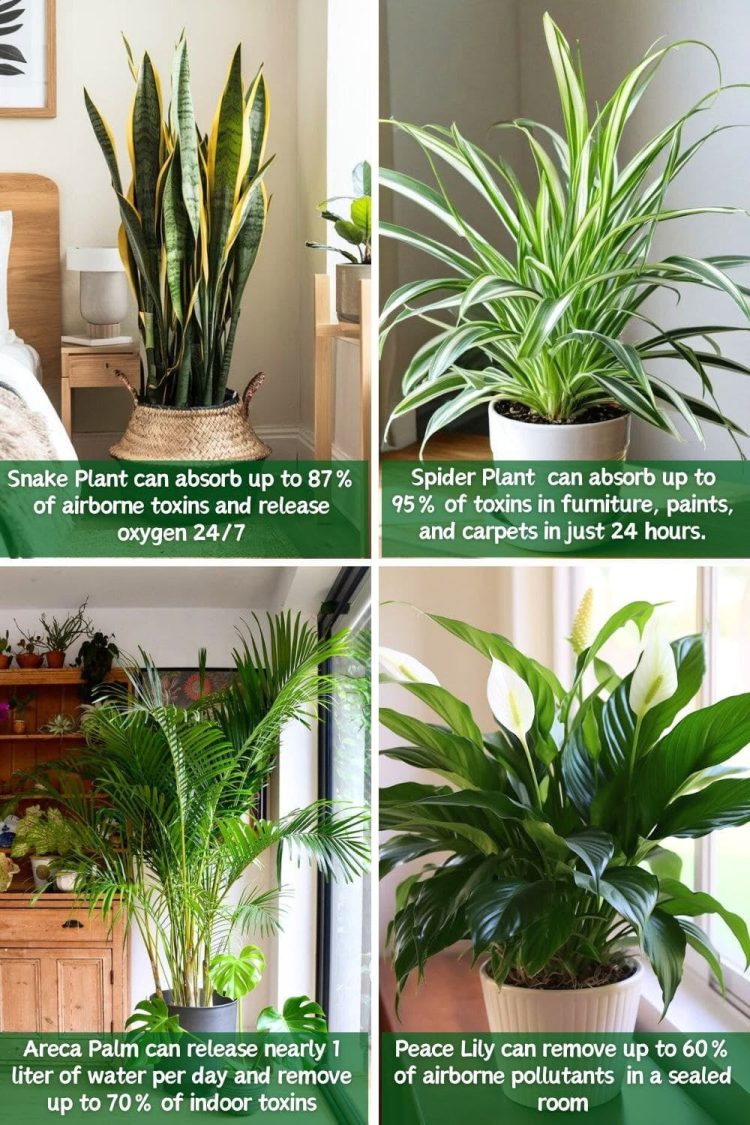The Snake Plant, also called Mother-in-Law’s Tongue, is unique among houseplants because it produces oxygen at night. While most plants switch to absorbing oxygen and releasing carbon dioxide during nighttime, the Snake Plant utilizes a special form of photosynthesis called Crassulacean Acid Metabolism (CAM), allowing it to continue generating oxygen around the clock.
Why It’s Ideal for Bedrooms:
- 24/7 Oxygen Production: Improves indoor air quality even while you sleep.
- Toxin Absorption: NASA studies show it can remove up to 87% of toxins like benzene, formaldehyde, and trichloroethylene.
- Low Maintenance: Extremely drought-tolerant and can survive low light and neglect.
- Durability: Perfect for beginners or busy people.
Care Tips:
- Light: Can tolerate low to bright indirect light.
- Water: Water sparingly; let soil dry out between waterings to prevent root rot.
- Temperature: Prefers 70-90°F (21-32°C); avoid frost.
- Soil: Well-draining soil mix, such as cactus soil.
3. Spider Plant (Chlorophytum comosum) – The Pollutant Absorber
The Spider Plant is a fast-growing, adaptable houseplant known for its remarkable ability to absorb airborne pollutants quickly and efficiently. It can remove up to 95% of common toxins such as formaldehyde, carbon monoxide, and benzene within 24 hours, making it a go-to for improving indoor air quality in poorly ventilated spaces.
Why It’s Popular for Homes and Offices:
- Rapid Growth: Produces “babies” or spiderettes that can be propagated easily.
- Effective Toxin Removal: Cleans the air rapidly and increases oxygen levels.
- Pet Safe: Non-toxic to cats and dogs, which is great for pet owners.
- Versatile: Can grow well in varying light conditions.
Care Tips:
- Light: Thrives in bright, indirect sunlight but tolerates low light.
- Water: Water when the top inch of soil feels dry; avoid soggy soil.
- Temperature: Prefers 55-80°F (13-27°C).
- Humidity: Does well in average home humidity but can benefit from occasional misting.
4. Peace Lily (Spathiphyllum) – The Air-Purifying Beauty
Peace Lilies are elegant plants that combine beauty with powerful air-cleaning abilities. According to NASA, Peace Lilies can remove up to 60% of indoor pollutants in sealed environments, including mold spores, formaldehyde, benzene, and carbon monoxide.
Why Peace Lilies Are a Must-Have:
- Air Purification: Particularly effective at removing mold spores and airborne allergens.
- Humidity Increase: Their lush foliage and flowers help raise indoor humidity, reducing dust and irritants.
- Visual Appeal: Glossy green leaves with graceful white blooms brighten any room.
- Compact Size: Fits well in offices, bedrooms, and bathrooms.
Care Tips:
- Light: Low to moderate indirect light; avoid direct sunlight which can scorch leaves.
- Water: Keep soil slightly moist; leaves will droop dramatically when thirsty, signaling it’s time to water.
- Temperature: Thrives between 65-80°F (18-27°C).
- Soil: Well-draining potting mix preferred.
Bonus Tips for Maximizing Your Indoor Plants’ Benefits
- Group Plants Together: Clustering plants can increase humidity and improve air quality more effectively.
- Regular Cleaning: Wipe leaves occasionally to remove dust that can block sunlight and reduce photosynthesis.
- Use Quality Soil: Healthy soil supports healthy plants that perform better at oxygen production.
- Avoid Overwatering: Too much water can cause root rot and reduce a plant’s ability to filter air.
- Choose Plants Suited to Your Space: Match plants with the light, temperature, and humidity of your room for optimal growth.
Final Thoughts
Bringing plants into your home isn’t just about decoration—it’s about creating a healthier, more vibrant living environment. The Areca Palm, Snake Plant, Spider Plant, and Peace Lily are four of the most effective oxygen-producing and air-purifying houseplants you can add to your collection. With proper care, these green companions can enhance your well-being, improve air quality, and add a refreshing touch of nature to your indoor spaces.
So why wait? Choose one (or more!) of these plants to breathe new life into your home today.
